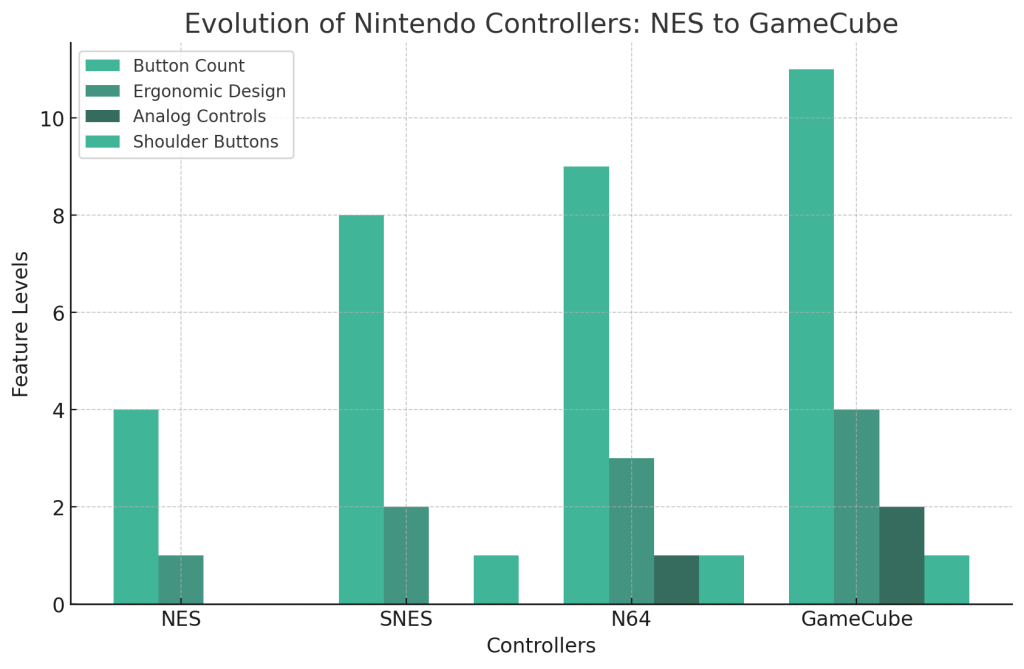Understanding the NES Controller’s Design
The Nintendo Entertainment System (NES) is more than just a console; it represents a foundational moment in gaming history. When it debuted in the 1980s, it brought with it a controller that would set a standard for generations to come. This controller, though simplistic by today’s standards, was revolutionary in its time and laid the groundwork for future ergonomic designs.
| Aspect | Description |
|---|---|
| NES Controller | Marked by simplicity, featuring a D-Pad and minimal buttons, emphasizing ease of use |
| Transition to SNES | Introduction of more buttons and shoulder buttons, reflecting the increasing complexity of games |
| Ergonomic Shifts | Gradual shift to more comfortable designs, with rounded grips and softened edges |
| N64 Revolution | Introduction of the analog stick, a game-changer for 3D gaming experiences |
| Game-Controller Synergy | Design of controllers influenced by and for specific games, enhancing gameplay |
The NES controller was a rectangular piece of hardware, distinct in its lack of frills. With a D-Pad on the left, two action buttons (A and B) on the right, and a pair of start and select buttons at the center, it embodied a minimalist approach. This design was a reflection of the era’s game design philosophy, which prioritized straightforward, accessible gameplay. The games of that time, such as “Super Mario Bros.” and “The Legend of Zelda,” required a controller that was easy to use and understand, making the NES controller perfectly suited to its purpose.
One of the key aspects of the NES controller’s design was its D-Pad, a cross-shaped button that allowed players to control movement in four directions. This D-Pad was a significant ergonomic advancement over the joystick controls common in arcade games and earlier consoles like the Atari 2600. It provided a more intuitive and precise way to control on-screen action, which was crucial for the platforming and adventure games popular on the NES.
Ergonomically, the NES controller was a product of its time. Its flat and rectangular shape, while iconic, was not designed with long-term comfort in mind. During prolonged gaming sessions, players often experienced discomfort or fatigue, issues that later controllers would strive to address. However, its lightweight design and the tactile response of its buttons were praised, making it a beloved piece of gaming history.
Furthermore, the NES controller’s design philosophy of simplicity and functionality resonated with gamers and developers alike. It demonstrated that a controller didn’t need to be complex to be effective. This principle influenced not only Nintendo’s future controller designs but also the entire gaming industry. The NES controller’s legacy is evident in how it balanced the needs of the time with a vision for the future, a testament to Nintendo’s understanding of the intersection between technology, design, and user experience.
The Leap to SNES: More Buttons, More Control
With the advent of the Super Nintendo Entertainment System (SNES), Nintendo took a significant leap forward in controller design. The SNES era marked a period of rapid evolution in video games, with titles becoming more complex and demanding more intricate control schemes. This complexity necessitated a shift from the NES’s simplicity to a more feature-rich controller.
The SNES controller retained the basic layout of the NES controller but introduced significant enhancements. It added two additional face buttons, labeled “X” and “Y,” increasing the range of inputs for more complex game mechanics. This expansion was not merely a quantitative increase in buttons but represented a qualitative shift in how players interacted with games. The SNES controller allowed for more nuanced control, enabling more sophisticated gameplay experiences in titles like “Super Mario World” and “The Legend of Zelda: A Link to the Past.”
Another major ergonomic advancement with the SNES was the introduction of shoulder buttons. These L and R buttons, positioned on the top of the controller, were a game-changer. They provided additional control options without overcrowding the controller’s face. This was especially beneficial for genres that demanded quick reflexes and complex input combinations, such as fighting and action games. The shoulder buttons also marked the beginning of Nintendo’s exploration into three-dimensional control schemes, a precursor to the analog sticks that would appear in later generations.
Ergonomically, the SNES controller showed Nintendo’s growing awareness of the importance of comfort in controller design. The controller’s edges were rounded off, offering a more comfortable grip than the NES controller. This design change indicated an understanding that as games grew longer and more engaging, the physical interaction with the controller needed to be less taxing on the hands and fingers of the players.
The SNES controller’s design was both a response to the evolving needs of games and gamers and a forward-looking innovation. It laid the groundwork for future controllers, not only in terms of button layout and functionality but also in ergonomic design. The SNES controller was a critical step in the evolution of gaming ergonomics, bridging the gap between the simplicity of the NES and the more complex needs of future gaming systems.
Ergonomics in Focus: From NES to SNES
The transition from the NES to the SNES also highlighted a significant evolution in the focus on ergonomics. As video games began to require longer periods of engagement from players, the comfort and usability of controllers became increasingly important. This shift was evident in the design changes that Nintendo implemented when moving from the NES to the SNES controller.
The NES controller, with its iconic rectangular shape and flat design, was functional but not necessarily designed with long-term comfort in mind. Players often reported discomfort during extended gaming sessions, a challenge that Nintendo addressed with the SNES. The SNES controller introduced rounded edges and a more contoured shape, significantly improving the grip and reducing hand fatigue. This ergonomic improvement was not just a matter of comfort but also enhanced the overall gaming experience, allowing players to engage with games for longer periods without discomfort.
Additionally, the SNES controller’s button layout was designed with ergonomics in mind. The placement of the new shoulder buttons and the arrangement of the face buttons were carefully considered to ensure that they were easily accessible and required minimal strain to use. This attention to detail in button placement and design demonstrated an understanding of the physical interaction between the player and the controller, a key aspect of ergonomic design.
The N64: A Bold Leap into 3D Gaming
The Nintendo 64 (N64) marked another significant milestone in the evolution of gaming ergonomics. With the introduction of the N64, Nintendo not only advanced the technology of gaming consoles but also reimagined the video game controller. The N64 controller was designed specifically to facilitate the new possibilities of 3D gaming, a rapidly growing trend at the time.
The most notable feature of the N64 controller was its analog stick, a first for Nintendo. This analog stick allowed for a level of precision and fluidity in movement that was essential for navigating the 3D environments of games like “Super Mario 64” and “The Legend of Zelda: Ocarina of Time.” The ergonomic design of the analog stick, positioned for easy thumb access, represented a significant shift from the D-Pad and was a clear response to the demands of 3D gameplay.
Moreover, the N64 controller featured a unique “M” shaped design, which was a departure from previous controllers. This design allowed players to hold the controller in different ways, depending on the game being played. While this design was innovative, it also presented new ergonomic challenges, as the controller’s shape was not universally praised for comfort. Despite these challenges, the N64 controller’s design was a bold step towards integrating ergonomic considerations with the functional requirements of new gaming technologies.
The GameCube: Refining Nintendo’s Ergonomic Approach
Advancing from the N64, the Nintendo GameCube controller further illustrated Nintendo’s commitment to ergonomic design. This controller was a response to the mixed feedback received from the N64’s unique design, showcasing Nintendo’s willingness to adapt and improve. The GameCube controller maintained the basic shape of the N64 controller but introduced several refinements that significantly enhanced its ergonomic appeal.
The GameCube controller’s most notable ergonomic feature was its comfortable grip. The controller was designed with a more natural hand position in mind, reducing strain during extended gaming sessions. This focus on comfort was a clear indication of Nintendo’s understanding that the physical interaction with a controller is a crucial part of the gaming experience. Additionally, the placement of the buttons and analog sticks was optimized for ease of access and intuitive use, ensuring that players could focus on the game without being hindered by the controller’s layout.
Furthermore, the GameCube controller introduced a second analog stick, aligning with the industry trend towards dual stick controls. This addition was not just a functional enhancement but also an ergonomic one, as it provided a symmetrical layout that was more natural for the hands to navigate. The controller also featured a unique button layout with a large central A button, surrounded by smaller B, X, and Y buttons, a design choice that prioritized ease of use and quick accessibility.
Analogue Revolution: A Paradigm Shift
The introduction of the analog stick in the N64 controller marked a paradigm shift in the gaming industry, greatly influencing ergonomic design. This shift was propelled further with the GameCube’s dual analog sticks, underscoring the industry’s move towards more intuitive and natural control mechanisms. The analog stick allowed for more precise and nuanced control, especially important in the growing number of 3D games. This evolution in control technology necessitated an ergonomic design that could accommodate the new level of complexity while maintaining comfort and accessibility.
The Future of Controller Ergonomics
Looking ahead, the evolution of controller ergonomics hints at a future where even more advanced technologies like motion sensing, haptic feedback, and perhaps even virtual reality integrations could become commonplace. These developments will continue to challenge and redefine the boundaries of ergonomic design, ensuring that the physical interface between the gamer and the game remains as seamless and comfortable as possible.
Learning from the Past
The historical progression from NES to N64 serves as a valuable lesson for future controller design. It teaches us that while technological advancements are crucial, understanding the physical and psychological comfort of the gamer is equally important. Future designs will likely continue to draw inspiration from this rich history, combining innovative technology with ergonomic principles that have been refined over decades.
The Role of User Feedback in Ergonomic Design
User feedback has been and will continue to be a vital component in the evolution of controller ergonomics. From the complaints about the N64 controller causing blisters to the widespread acclaim of the GameCube controller’s comfortable grip, consumer responses have significantly influenced Nintendo’s design choices. This ongoing dialogue between the gamers and the creators is essential in shaping controllers that not only meet the technological requirements of modern gaming but also the ergonomic needs of the users.
Conclusion
The evolution of controller ergonomics from the NES to the N64 and beyond is a story of continuous adaptation and innovation. It reflects a deep understanding of the physical interaction between gamer and game, an interaction that is as crucial to the gaming experience as the game itself. From the simple, block-like NES controller to the more complex and ergonomic designs of the SNES, N64, and GameCube, Nintendo’s journey showcases a dedication to enhancing the gaming experience through innovative and comfortable controller designs.

